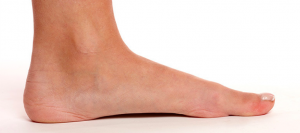Help! I’ve Got Flat Feet
April 1, 2018
When we see patients for whatever problem or pain they’re having, one thing that they’re often quick to point out is having flat feet (for those that do). This happens because a lot of people associate having flat feet with having foot problems, regardless of their history of foot pain or if their flat-footedness has resulted in their problems or not.
Because this is a common thought pattern among patients (well, at least in our experience here in Auckland), we thought we’d share a little more about flat feet and what they REALLY mean.
 The symptoms of flat feet aren’t necessarily painful themselves, but the stress and pressure they put on the surrounding tendons and structures can cause pain as tendinopathies and other issues develop. These tend to be exacerbated by long periods of time on the feet and high-impact activities.
When podiatrists evaluate the severity of flat feet, they often look for signs as opposed to symptoms. These include:
The symptoms of flat feet aren’t necessarily painful themselves, but the stress and pressure they put on the surrounding tendons and structures can cause pain as tendinopathies and other issues develop. These tend to be exacerbated by long periods of time on the feet and high-impact activities.
When podiatrists evaluate the severity of flat feet, they often look for signs as opposed to symptoms. These include:
Flat feet: The basics
Having flat feet describes the biomechanical and structural position of the feet, which is characterised by rolling in at the ankles and showing little to no arch on the inside border of a foot. This is how the term ‘fallen arches’ was coined. This is medically referred to as pes planus, with the term for rolling in at the ankle joint when walking known as pronation. As the severity of pronation can range from mild to severe, podiatrists can measure the angle of your shin bone relative to your calcaneus, or use a Foot Posture Index (FPI), to help grade the level of pronation and best direct treatment where it is indicated. It should be noted that:- Flat feet are relatively common, and that having flat feet does not mean you are definitely going to have foot or leg issues or pains
- Pronation is also a natural and necessary part of each step we take, helping our feet to absorb shock and adapt to the uneven surfaces
What causes flat feet and overpronation?
Typically, it comes down to the biomechanics of your feet and the way your bones, joints, muscles and ligaments are working together. Some people may have flat feet from birth and others may develop them over time and in association with other conditions. Causes may include:- Bone or joint irregularity
- Muscle weakness
- Tendonitis, such as in the posterior tibial tendon
- Ligament laxity
- Obesity
- Pregnancy
- Injury / Trauma
- Arthritis
- Diabetes
What are the symptoms of flat feet?
 The symptoms of flat feet aren’t necessarily painful themselves, but the stress and pressure they put on the surrounding tendons and structures can cause pain as tendinopathies and other issues develop. These tend to be exacerbated by long periods of time on the feet and high-impact activities.
When podiatrists evaluate the severity of flat feet, they often look for signs as opposed to symptoms. These include:
The symptoms of flat feet aren’t necessarily painful themselves, but the stress and pressure they put on the surrounding tendons and structures can cause pain as tendinopathies and other issues develop. These tend to be exacerbated by long periods of time on the feet and high-impact activities.
When podiatrists evaluate the severity of flat feet, they often look for signs as opposed to symptoms. These include:
- Shoes wearing out quickly on the inner side
- Talonavicular bulging (a bulge on the inside of the foot)
- Abducted forefoot (seeing your toes pushing out on the outside of the feet when looking at the heel)
- The position of your heel bone and whether it’s rolling in or out
- The shape of your arch
- Talar head palpation (being able to feel the head of your talus bone at the ankle evenly when you’re standing)
- The curvature below your malleoli (bony bumps on the sides of your ankle)
- The position of your feet in a ‘neutral’ position (referred to as ‘subtalar joint neutral’) versus their position when standing relaxed
